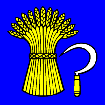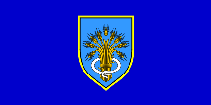- GAFF
- A spar rigged at an upward angle from the upper part of a mast or pole, and
equipped with a halyard at its highest point from which an ensign is flown when
at the peak. A gaff may be fitted to the mizzenmast (or other masts dependent upon the rig) of a sailing ship, or from
the mast of a warship (when it will sometimes carry a command flag), or from a
mast (or stayed mast) ashore (see also fore,
halyard,
mast,
mizzen,
outrigger pole,
peak,
sailors mast,
shift colours and
stayed mast).
Please note that if a gaff is fitted to a flag pole or mast for civilian
or naval use ashore, it is generally (but not exclusively) that flag which is used as a
naval/civil ensign (or a yacht ensign if appropriate) which is flown from its peak (see also
civil ensign and
yacht ensign under
ensign).
Also please note, that (whilst underway) sailing ships - whether civilian or naval -
still have the option of flying their ensigns for the peak of the gaff if fitted, or from two-thirds the way up
the leech of the mainsail if Bermuda rigged (see also leech).
- GAJARDUS
- A medieval term, now obsolete, for the carriage upon which a standard was fixed
a carrocerum (see also standard 6)
and vexilloid).
Please note that in the early-middle ages, standards were
sometimes (for reasons which are now unclear) transported into battle and displayed
whilst mounted on some form of wheeled conveyance.
- GALHARDETE
- A Portuguese generic term that covers a number of small flags or pennants (in several, varying types),
often given away or sold as souvenirs.
- GALLERY
- A bar running at right angles from the staff from which the flag is partially suspended.
Please note, however, that use of the term with this meaning is
given by only one source, and that such use is otherwise unsupported.
- GARBE (or GARB)
- The heraldic term for a sheaf of wheat or corn.



Flag of Freienwil, Switzerland (fotw); Flag and Arms of Sopje, Croatia (fotw)
- GARDANT
- See guardant in Appendix V.
- GARLAND
- 1) In heraldry, a term for a closed or almost closed ring consisting
of intertwined leaves, or of leaves and flowers a chaplet or orle
(see also
wreath 1)).
- 2) On flags as above, but the term is also used to describe an open topped
wreath composed of leaves, or of leaves and/or flowers, that does not exceed
two-thirds the depth of the object surrounded (for example that on the flag of
Parana, Brazil) or sometimes considerably less but see
wreath 1.
![[garland]](../images/v/vxt-d153.gif)
From left: Flag of Parana, Brazil (fotw); A Garland in Heraldry According to English Heraldic Practice (Parker)
Please note with regard to 1), that the English heraldic
requirement of only four flowers per garland is not generally observed in flags.
- GARNISHED
- The heraldic term used when a charge (such as a horn, helmet or mitre etc) is decorated or ornamented
with details in another tincture (see also charge 1),
barbed,
hafted,
hilted,
shafted and
tincture). ).



Flag of Horn, Netherlands (fotw); Arms and Flag of Granja, Portugal (Antonio Martins)
- GARRISON FLAG
- In US usage, the largest of the three standard sizes of national flag flown
at army posts - 20 x 38 feet or 6.1 x 10.9m (see also
post flag 1),
storm flag and
war flag).
Please note that the use of standard sizes of flag
at army posts is by no means limited to the US (although the names may differ),
and that the largest size is the one displayed on days of national celebration
and/or service significance, or as otherwise regulated (see also
ceremonial ensign,
holiday colours and
Sunday ensign).
- GENEVA CONVENTION FLAG
- See 'safe conduct flag 1)'.
- GERONNY
- See gyronny.
- GIN PENNANT (or PENDANT)
- In British RN and some other usage, an unofficial pennant of varying design now
often a defaced version of the starboard pennant in the NATO signalling code raised
when a ships officers wish to entertain the officers of another ship or ships
(see also pennant 2) and
senior officer afloat pennant).
![[Gin Pennant]](../images/v/vxt-d505.gif)
One version of the gin pennant, UK (CS)
Please note that the above is usually made on board
from whatever materials lie to hand, however, the company Gordons Gin are known to
have supplied a number of commercially produced gin pennants to yachtsmen in the 1950s.
![[commercial Gin Pennant]](../images/v/vxt-d505a.gif)
Commercially Produced Gin Pennant c1955, UK (CS)
- GIRON(S)
- See gyronny
- GIRONNΙ
- See gyronny.
- GITON (GETON or GYTTON)
- A medieval term, now obsolete, used to describe a small (possibly swallow
tailed) flag (see also pennant and
pennon 2).
Please note that there is no proven connection between
these terms and guidon, but that the similarity
cannot be ignored.
- GOBONY (GOBONΙ or GOBONATED)
- See compony.
- GOLDEN MEAN, THE
- That proportion, first recorded by classical Greek sources, which is considered
particularly pleasing to the human eye; it is the ratio of two values where the
relationship of the smaller (A) to the larger (B) is the same as that of the larger
to the total, and has the value of (in round figures) 0.618 (with the reciprocal
being 1:1618). It is most usually seen on flags as proportions of either 5:8 or
3:5 - the divine, golden or magic ratio, or golden section.
![[graphic of golden mean]](../images/v/vxt-d155.gif)
Please note from the illustration that ratio a:b
is the same as b: a+b, with the exact value being
![[graphic of equation]](../images/v/vxt-d158.gif) , or 0.6180339887
, however,
it is suggested that a mathematical reference work be consulted if further or
more complete details are required.
, or 0.6180339887
, however,
it is suggested that a mathematical reference work be consulted if further or
more complete details are required.
- GOLDEN RATIO (or SECTION)
- See golden mean above.
- GONFALON (or GONFALONE)
- 1) The term for a usually long (sometimes elaborate) flag designed to be
hung vertically from a cross bar, often having a shaped and/or fringed bottom
edge or terminating in tails or tongues and characteristic of Italy and of
Central Europe, or of the religious associations in Western Europe where it
might also be called a religious banner (see also
banner 2),
banner 3),
ceremonial flag 1),
dexter edge 2),
sinister edge 2),
square-tongued,
stepped gonfalon,
tongue(s),
triangular-ended
and triangular-ended tails).
- 2) The term sometimes used for a flag that is designed to be attached both along its hoist to the staff, and
along its top to a side-mounted cross-bar - but see
framed flag 2) (also ring 4)).
![[gonfalon]](../images/v/vxt-d159.jpg)

Gonfalon of Asciano Tuscany, Italy (fotw); Gonfalon of Delianuova, Italy (fotw)
Please note not to be confused with a medieval gonfanon
or with the hanging flag of German speaking and Central European countries (see
also hanging flag, and
gonfanon).
- GONFALONI SCALINATI
- See stepped gonfalon.
- GONFALONIER
- The bearer of a gonfalon or standard (see also
standard bearer).
- GONFALONIERSHIP
- A term, now largely (if not wholly) obsolete, for the - often hereditary -
honorary office of gonfalonier (standard or flag bearer) to a monarch (see
also archivexillifer).
- GONFANON
- A war flag of pre-heraldic Europe, often tapered from hoist to fly, generally
attached to a lance and ending in from two to five squared, rounded or triangular
tails. Not to be confused with the later gonfalon
(see also double-tailed descate,
lanceolate,
oriflamme,
pallia,
pre-heraldic,
multi-tailed descate,
'square-tongued',
swallow-tailed(ed),
swallowtail and tongue and
triple-tailed descate).
![[gonfanon]](../images/v/vxt-d161.gif)
Gonfanon of Eustache III of Auvergne c1100 (CS)
- GONTFANONARIUS (or GONFAGONIER)
- A medieval term, now obsolete, for a standard bearer.
- GORE(S)
- The generic term for a tapering piece or pieces of fabric that is sometimes used to describe
the triangular blue fields of the British union jack (see also
union flag 1),
union jack 1) and
union jack 2)).

Army Pattern of Union Flag, UK (fotw)
- GORGED
- The heraldic term used when a beast or bird (and occasionally another charge) is shown with its collar in a
different tincture - this may be either plain or decorated and is sometimes in the form of a coronet collared
or accolι (see also
appendix V,
armed 2),
attired,
beaked,
jelloped,
langued,
membered and
tincture).



Flag of Oland, Sweden (fotw); Arms of Posedarje, Croatia (fotw); Flag of Combremonts, Switzerland (fotw)
- GOUTTES (GOUTΙ or GOUTTY)
- The heraldic term for a number of charges (usually specified) in the shape of a teardrop guttι, gutty,
goutty, goutι or larmes.




Flag and Arms of Bistra, Croatia (fotw); Flag and Arms of Tuhelj, Croatia (fotw)
Please note that this term may be variously used dependent upon the tincture,
and we suggest that a suitable glossary or dictionary of heraldry be consulted for full details.
- GOVERNMENT ENSIGN
- See under ensign.
- GOVERNMENT FLAG
- See state flag 1).



![[garland]](../images/v/vxt-d153.gif)



![[Gin Pennant]](../images/v/vxt-d505.gif)
![]() , or 0.6180339887
, however,
it is suggested that a mathematical reference work be consulted if further or
more complete details are required.
, or 0.6180339887
, however,
it is suggested that a mathematical reference work be consulted if further or
more complete details are required. ![[gonfalon]](../images/v/vxt-d159.jpg)










![[commercial Gin Pennant]](../images/v/vxt-d505a.gif)
![[graphic of golden mean]](../images/v/vxt-d155.gif)
![[gonfanon]](../images/v/vxt-d161.gif)